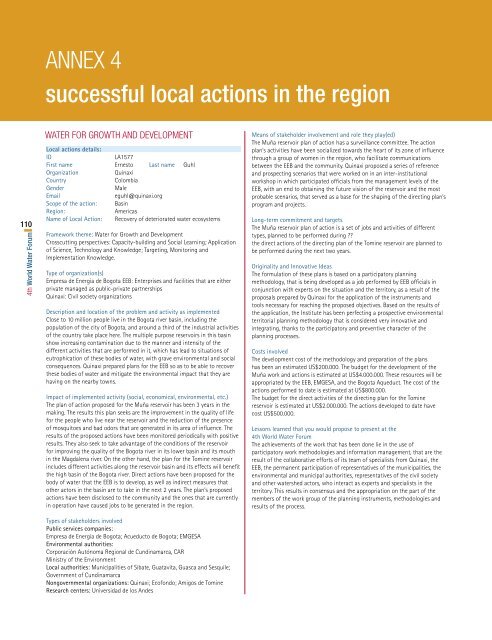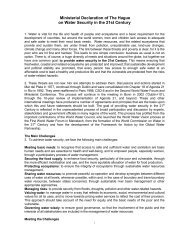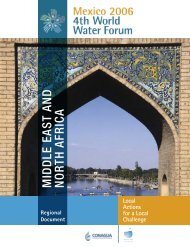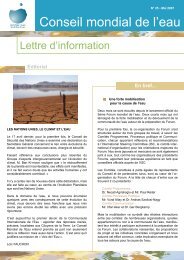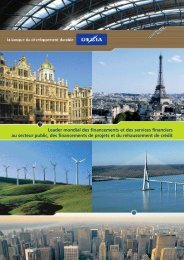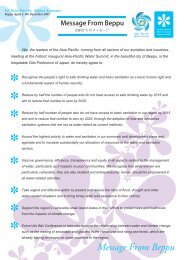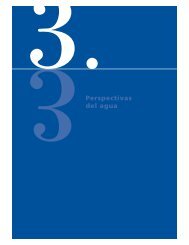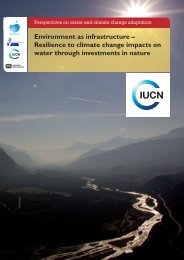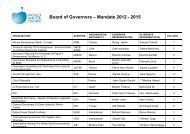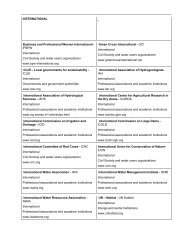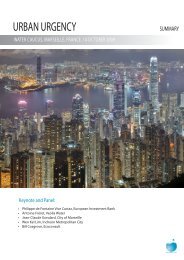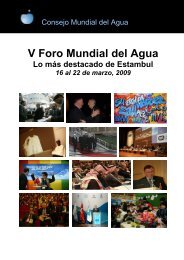ANNEX 4successful local actions in the region1104th <strong>World</strong> <strong>Water</strong> ForumWATER FOR GROWTH AND DEVELOPMENTLocal actions details:IDLA1577First name Ernesto Last name GuhlOrganizationQuinaxiCountryColombiaGenderMaleEmaileguhl@quinaxi.orgScope of the action: BasinRegion:<strong>Americas</strong>Name of Local Action: Recovery of deteriorated water ecosystemsFramework theme: <strong>Water</strong> for Growth and DevelopmentCrosscutting perspectives: Capacity-building and Social Learning; Applicationof Science, Technology and Knowledge; Targeting, Monitoring andImplementation Knowledge.Type of organization(s)Empresa de Energia de Bogota EEB: Enterprises and facilities that are eitherprivate managed as public-private partnershipsQuinaxi: Civil society organizationsDescription and location of the problem and activity as implementedClose to 10 million people live in the Bogota river basin, including thepopulation of the city of Bogota, and around a third of the industrial activitiesof the country take place here. The multiple purpose reservoirs in this basinshow increasing contamination due to the manner and intensity of thedifferent activities that are performed in it, which has lead to situations ofeutrophication of these bodies of water, with grave environmental and socialconsequences. Quinaxi prepared plans for the EEB so as to be able to recoverthese bodies of water and mitigate the environmental impact that they arehaving on the nearby towns.Impact of implemented activity (social, economical, environmental, etc.)The plan of action proposed for the Muña reservoir has been 3 years in themaking. The results this plan seeks are the improvement in the quality of lifefor the people who live near the reservoir and the reduction of the presenceof mosquitoes and bad odors that are generated in its area of influence. Theresults of the proposed actions have been monitored periodically with positiveresults. They also seek to take advantage of the conditions of the reservoirfor improving the quality of the Bogota river in its lower basin and its mouthin the Magdalena river. On the other hand, the plan for the Tomine reservoirincludes different activities along the reservoir basin and its effects will benefitthe high basin of the Bogota river. Direct actions have been proposed for thebody of water that the EEB is to develop, as well as indirect measures thatother actors in the basin are to take in the next 2 years. The plan’s proposedactions have been disclosed to the community and the ones that are currentlyin operation have caused jobs to be generated in the region.Means of stakeholder involvement and role they play(ed)The Muña reservoir plan of action has a surveillance committee. The actionplan’s activities have been socialized towards the heart of its zone of influencethrough a group of women in the region, who facilitate communicationsbetween the EEB and the community. Quinaxi proposed a series of referenceand prospecting scenarios that were worked on in an inter-institutionalworkshop in which participated officials from the management levels of theEEB, with an end to obtaining the future vision of the reservoir and the mostprobable scenarios, that served as a base for the shaping of the directing plan’sprogram and projects.Long-term commitment and targetsThe Muña reservoir plan of action is a set of jobs and activities of differenttypes, planned to be performed during ??the direct actions of the directing plan of the Tomine reservoir are planned tobe performed during the next two years.Originality and Innovative IdeasThe formulation of these plans is based on a participatory planningmethodology, that is being developed as a job performed by EEB officials inconjunction with experts on the situation and the territory, as a result of theproposals prepared by Quinaxi for the application of the instruments andtools necessary for reaching the proposed objectives. Based on the results ofthe application, the Institute has been perfecting a prospective environmentalterritorial planning methodology that is considered very innovative andintegrating, thanks to the participatory and preventive character of theplanning processes.Costs involvedThe development cost of the methodology and preparation of the planshas been an estimated US$200.000. The budget for the development of theMuña work and actions is estimated at US$4.000.000. These resources will beappropriated by the EEB, EMGESA, and the Bogota Aqueduct. The cost of theactions performed to date is estimated at US$800.000.The budget for the direct activities of the directing plan for the Tominereservoir is estimated at US$2.000.000. The actions developed to date havecost US$500.000.Lessons learned that you would propose to present at the4th <strong>World</strong> <strong>Water</strong> ForumThe achievements of the work that has been done lie in the use ofparticipatory work methodologies and information management, that are theresult of the collaborative efforts of its team of specialists from Quinaxi, theEEB, the permanent participation of representatives of the municipalities, theenvironmental and municipal authorities, representatives of the civil societyand other watershed actors, who interact as experts and specialists in theterritory. This results in consensus and the appropriation on the part of themembers of the work group of the planning instruments, methodologies andresults of the process.Types of stakeholders involvedPublic services companies:Empresa de Energía de Bogota; Acueducto de Bogota; EMGESAEnvironmental authorities:Corporación Autónoma Regional de Cundinamarca, CARMinistry of the EnvironmentLocal authorities: Municipalities of Sibate, Guatavita, Guasca and Sesquile;Government of CundinamarcaNongovernmental organizations: Quinaxi; Ecofondo; Amigos de TomineResearch centers: Universidad de los Andes
Local actions details:IDLA1171First name Julio Last name RuanoOrganizationItzamna Society (El Progreso Community<strong>Water</strong> Committee (7 miles))CountryBelizeGenderMaleEmailArtistmai1981@btl.netScope of the action: DistrictRegion:<strong>Americas</strong>Name of Local Action: Community Drinking <strong>Water</strong> Management byGravityFramework theme: <strong>Water</strong> for Growth and DevelopmentCrosscutting perspectives: Institutional Development and Political Processes;Capacity-building and Social LearningName and types of the implementing organization(s)Itzamna Society: Civil society organizationOriginality and Innovative IdeasYes, the system can be considered innovative because of the system ofgravity. The system was made possible thanks to the Mennonite community’sknowledge and its technology at the local level and thanks to the experiencethey have in the water system.Costs involvedThe cost of the project was US$350,000, and the measures that were takento reduce costs are that the community provided the manual labor worthUS$55,000. The funds for the project were given by the Social Investment Fund(SIF).Lessons learned that you would propose to present at the4th <strong>World</strong> <strong>Water</strong> ForumYes, the system can be one of experience for other communities because itis a system using gravity without the cost of fuel and is administered by thecommunity; there can be exchanges with other groups who are interested inthe possibility of having a system by gravity.Description and location of the problem and activity as implementedThe resource of water was insufficient for the community and the water thatwas being used was unhealthy. So a proposal was presented for a drinkingwater system for the community of El Progreso (7 miles), Pine Ridge Road,Cayo District, Belize, Central America. The drinking water system projectwas undertaken in 2002 and it solved the problem of incomprehension inthe community, and now has brought development to the community. Thedifficulties were access to funds for the undertaking of the project, the difficultaccess to the area, and the fact that the Government was very slow and didnot respond to the needs of the community.Impact of implemented activity (social, economical, environmental, etc.)The result that is expected is that there be healthy drinking water for all thehomes in the community. After the installation of the system the communitywas given 7 months of water for free and then a monthly fee was instituted.With the monies gathered in this way, expansion jobs were performed in thecommunity. Now, the time that used to be put into lo<strong>ok</strong>ing for water is pouredinto other work, the water that is consumed is healthy, and jobs have beencreated. The economic impact is that now there are more farming productsbecause there is irrigation. Thanks to the water system, 13,006 acres of forestbelow the National Park have been protected, and this has had an impact atthe local level, on the watershed, and at the national level as well. The fact thatapproximately 3000 indigenous inhabitants and peasants now have drinkingwater has had an indirect impact on them.Types of stakeholders involvedThe result that is expected is that drinking water has reached the homesin the community. After the installation of the system the community wasgiven 7 months of water for free and then a monthly fee was instituted.With the monies gathered in this way, expansion jobs were performed in thecommunity. Now, the time that used to be put into lo<strong>ok</strong>ing for water is pouredinto other work, the water that is consumed is healthy, and jobs have beengenerated. The economic impact is that now there are more farming productsbecause there is irrigation. Thanks to the water system, 13,006 acres of forestbelow the National Park have been protected, and this has had an impactat the local level, on the watershed, and at the national level. The fact thatapproximately 3000 indigenous inhabitants and peasants now have drinkingwater has had an indirect impact on them.Means of stakeholder involvement and role they play(ed)1. The Community and the Village <strong>Council</strong> that undertake the planning ofthe work and the manual labor.2. SIF- Provided the funds for the system’s project.3. The Mennonite Community and religious groups – technical assistance.Long-term commitment and targetsThe monthly fee goes to the maintenance of the system and to a fund that ismanaged by the water committee; these funds will serve to renew the systemlong-term, and each 3 months there is a community meeting where a financialreport is generated. The commitments are that there is to be supervision onthe part of the local Government, and there are the regulations of the watercommittee’s certificate.Local actions details:IDLA1199First name Gustavo Last name HerediaOrganizationPrograma Agua TuyaCountryBoliviaGenderMaleEmailgustavoh@aguatuya.comScope of the action: CityRegion:<strong>Americas</strong>Name of Local Action: Creation of “<strong>Water</strong> Committees” in peri-urbanzones (local action to be presented at the IDTS0050 session organized by the WECF part of theWomen’s Coalition)Framework theme: <strong>Water</strong> for Growth and DevelopmentCrosscutting perspectives: New Models for Financing Local <strong>Water</strong> Initiatives;Application of Science, Technology and KnowledgeName and types of the implementing organization(s)PLASTIFORTE SRL: Enterprises and facilities that are either private managed aspublic-private partnerships<strong>Water</strong> Committees: Civil society organizationsMunicipalities, municipality associations and the Municipal Drinking<strong>Water</strong> Company (Empresa Municipal de Agua Potable): National and localGovernments, authorities and associated.Description and location of the problem and activity as implementedIn the department of Cochabamba (Bolivia) there is a great demand fordrinking water and sanitation services. Due to the lack of attention on thepart of the public sector, the peri-urban and rural districts of the mainmunicipalities of the department are organized around the water problem andare starting to build solutions of their own. Many of the districts are forming“<strong>Water</strong> Committees” (organized civil society) in order to take on small drinkingwater system construction projects. The Programa Agua Tuya (Your <strong>Water</strong>Program) is starting to offer integrated solutions in the field of water. Thecommunity acquires these distribution systems with its own resources andcovers 100% of the real costs of construction.Impact of implemented activity (social, economical, environmental, etc.)The Programa Agua Tuya (Your <strong>Water</strong> Program) to date has built over170 drinking water systems, giving access to water to more than 85,000inhabitants in poor peri-urban and rural areas.Types of stakeholders involvedThe Programa Agua Tuya (private program) centers all its activities onsupporting the <strong>Water</strong> Committees (organized civil society), using a demandfocus. That is, it is constantly seeking to satisfy the unsatisfied demands ofthe <strong>Water</strong> Committees. In order to be able to offer soft credit and so thatthe users (who turn into owners of the systems) can cover the investment1114th <strong>World</strong> <strong>Water</strong> Forum


